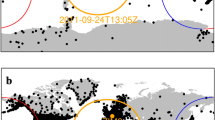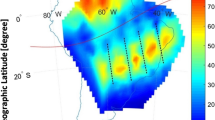Abstract
The L-band solar radio emission has recently been regarded as a potential threat to stable GPS and GLONASS performance. However, the threat has not been completely investigated or assessed so far. We evaluate in detail the occurrence of GPS/GLONASS signal tracking failures under the direct exposure of wideband solar radio emission. By means of theoretical analysis, we found that the solar radio emission power level of 1,000 sfu (solar flux units) or higher can cause GPS/GLONASS signal tracking failures especially at L2 frequency. In order to prove this evaluation, we investigated GPS/GLONASS signal tracking failures at L1 and L2 frequencies during power solar flares X6.5 (December 6, 2006) and X3.4 (December 13, 2006). Comparing these events with weaker solar flare X17.2 on October 28, 2003, we found that L2 signal tracking failures appeared when the solar radio emission power exceeds 1,000 sfu. Therefore, our theoretical and experimental results confirm the earlier results by other authors.







Similar content being viewed by others
References
Afraimovich EL (2000) GPS global detection of the ionospheric response to solar flares. Radio Sci 35(6):1417–1424
Afraimovich EL, Lesyuta OS, Ushakov II, Voeykov SV (2002a) Geomagnetic storms and the occurrence of phase slips in the reception of GPS signals. Ann Geophys 45(1):55–71
Afraimovich EL, Zherebtsov GA, Smolkov GYa (2002b) Total failure of GPS during a solar flare on December 6, 2006. Rep Earth Sci 417(8):1231–1235
Afraimovich EL, Demyanov VV, Ishin AB, Smolkov GYa (2008) Powerful solar radio bursts as a global and free tool for testing satellite broadband radio systems, including GPS-GLONASS-GALILEO. J Atmos Sol Terr Phys 70:1985–1994
Carrano CS, Groves KM, Bridgwood CT (2007) Effects of the December 2006 solar radio bursts on the GPS receivers of the AFRL-SCINDA network. In: Doherty PH (ed) Proceedings of the international beacon satellite symposium, June 11–15
Cerruti AP, Kintner PM, Gary DE, Lanzerotti LJ, de Paula ER, Vo HB (2006) Observed solar radio burst effects on GPS/WAAS carrier-to-noise ration. Space Weather 4:S10006. doi:10.1029/2006SW000254
Chen Z, Gao Y, Liu Z (2005) Evaluation of solar radio bursts’ effect on GPS receiver signal tracking within international GPS service network. Radio Sci 40:RS3012. doi:10.1029/2004RS003066
ICD-GPS-200c (1993) Interface control document. http://www.navcen.uscg.gov/pubs/gps/icd200/ICD200Cw1234.pdf
ICD-GLONASS (2002) Interface control document (in Russian). http://www.glonassgsm.ru/upl_instructions/-ICD-2002r.pdf
Jin SG, Luo O, Park P (2008) GPS observations of the ionospheric F2-layer behavior during the 20th November 2003 geomagnetic storm over South Korea. J Geod 82(12):883–892. doi:10.1007/s00190-008-0217-x
Kaplan ED (ed) (1996) Understanding GPS: principles and applications. Artech House, Norwood
Klobuchar JA, Kunches JM, Van Dierendonck AJ (1999) Eye on the ionosphere: potential solar radio burst effects on GPS signal to noise. GPS Sol 3(2):69–71
Perov AI, Kharisov VN (ed) (2005) GLONASS. Structure and principles of functioning (in Russian), Edition of Radio-electronics. Moskow
Skone S, de Jong M (2001) Limitations in GPS receiver tracking performance under ionospheric scintillation. Phys Chem Earth A 26(6–8):613–621
Acknowledgments
Authors express profound gratitude to Prof. G. Ya. Smolkov for his support and interest in this investigation, Dr. V. V. Grechnev for his help in using the 1 and 2 GHz data of the Nobeyama Radio Polarimeters and colleagues from the Nobeyama Radio Observatory, for solar radio emission data on December 13, 2006, as well as the IGS (http://lox.ucsd.edu/cgi-bin/al-lCoords.cgi?) and GEONET (ftp://terras.gsi.go.jp/data/GPS products/) for RINEX data. The work is supported by the Siberian Branch of the Russian Academy of Sciences and the Program of basic research of the Presidium of the Russian Academy of Sciences “Solar activity and physical processes in the Sun-Earth system”. Finally, the authors wish to thank the referees for their valuable suggestions which allowed us to improve the quality of the manuscript.
Author information
Authors and Affiliations
Corresponding author
Additional information
The article is dedicated to the memory of Prof. E. L. Afraimovich who founded the Irkutsk scientific school for GPS sounding of the ionosphere and effectively worked as a mentor of this school for years.
Rights and permissions
About this article
Cite this article
Demyanov, V.V., Afraimovich, E.L. & Jin, S. An evaluation of potential solar radio emission power threat on GPS and GLONASS performance. GPS Solut 16, 411–424 (2012). https://doi.org/10.1007/s10291-011-0241-9
Received:
Accepted:
Published:
Issue Date:
DOI: https://doi.org/10.1007/s10291-011-0241-9




